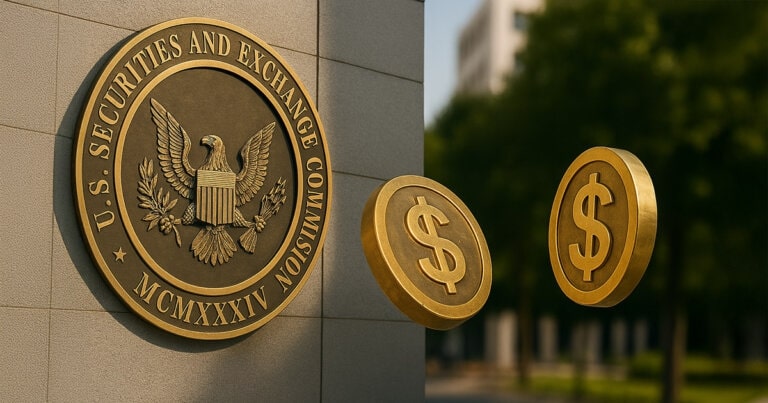SEC Approves Certain Stablecoins, Boosts Crypto Confidence

Key Takeaways:
- The SEC’s ruling has removed regulatory uncertainty for some stablecoins, which are now considered not to be securities by the Commission.
- Stablecoins are becoming more widely used for day-to-day payments and institutional purposes.
- Congress is edging closer to clarifying the laws governing stablecoin.
SEC Issues Guidance on “Covered” Stablecoins
On April 4, 2025, U.S. Securities and Exchange Commission (SEC) brought a ray of hope to the crypto world by announcing that certain stablecoins would not be classified as securities. Crypto advocates and financial institutions welcomed the decision, clarifying the regulatory landscape and setting the stage for broader adoption of dollar-pegged digital assets.
The SEC’s Division of Corporate Finance said that stablecoins, which satisfy certain strict parameters, would not be deemed securities under existing federal legislation. “Covered stablecoins” have to keep a 1:1 peg to the U.S. dollar, are fully redeemable, and backed by low-risk, liquid assets such as U.S. Treasury securities or money market funds. Reserves cannot include assets like precious metals or cryptocurrencies. The requirements aim to ensure stability, transparency, and trust — as stablecoins increasingly interact with the traditional financial system.
In addition, covered stablecoins can only be marketed for commerce, payments and storing the value, but not as investments. The SEC has confirmed that transactions involving minting and redemption of such stablecoins do not require registration under the Securities Act.
Regulatory clarity removes compliance uncertainty, empowering developers and companies building in the space to innovate. The new framework would even redefine how markets would serve us. Tether, for example, is considering a U.S.-registered stablecoin to satisfy compliance demand with CEO Paolo Ardoino stating it can complement USDT in emerging markets. Other major players are expected to follow suit, signaling a broader institutional shift toward regulatory-friendly digital assets.
Congress Moves Closer to Legislation on Stablecoins
The SEC’s move comes as Congress builds momentum formalizing a regulatory framework around stablecoins. President Trump said recently that he hoped lawmakers would pass stablecoin legislation before the August recess, providing rare bipartisan urgency in crypto policy.
Two major bills are currently pending:
- The Stablecoin Transparency and Accountability for a Better Ledger Economy (STABLE) Act, which is backed by the House Financial Services Committee.
- The Senate Banking Committee approved the bipartisan “Guiding and Establishing National Innovation for U.S. Stablecoins” (GENIUS) Act introduced by Senators Tim Scott and Bill Hagerty.
Each proposal would put in place oversight of stablecoin issuers, bolster consumer protections and combat illicit finance risks. They also demonstrate the increasing awareness of the economic potential of stablecoins — even as fears mount that the U.S. could lose its digital currency leadership.
In line with this trend, firms such as Circle are preparing for mainstream acceptance, and Circle recently filed for an IPO. If approved, it would be one of the most high-profile personalities to go public in the crypto space since the exchange Coinbase did so in 2021.

The Stablecoin Market: Growth at an Alarming Rate and Expanding Use Cases
Stablecoins today go beyond trading — they power DeFi, cross-border transfers, and payments with dollar stability, crypto flexibility, and fast settlements. In 2025 alone the stablecoin market exploded by 11%, and a 47% over the past 12 months. While Tether (USDT) and USD Coin (USDC) still top the market, newcomers and purpose-built stablecoins are emerging. Although dominant, Tether is recalibrating to global regulations by working on a U.S.-compliant stablecoin for stricter Western markets.
Yield-bearing stablecoins have exploded post-election, surpassing $13 billion and accounting for 6% of the market, but they are outside the SEC’s most recent guidance. Its “killer app” is their utility and reliability, making them the new face of crypto.
Interest-Bearing Stablecoins Remain in Legal Limbo
The SEC clarified its position on payment-focused stablecoins, explicitly excluding those offering interest to holders from the “covered” group. Features might move a stablecoin into the world of securities, triggering more complicated regulation. The SEC said holders of covered stablecoins won’t receive earnings, though issuers may profit from reserve assets.
Small technical differences, like whether a user can earn yield, can drastically change a product’s regulatory picture, as the wider discussion has shown.
More News: SEC Resets Its Crypto Relationship: Tackling a New Era — Or Just a Game Theory Adjustment?
The post SEC Approves Certain Stablecoins, Boosts Crypto Confidence appeared first on CryptoNinjas.